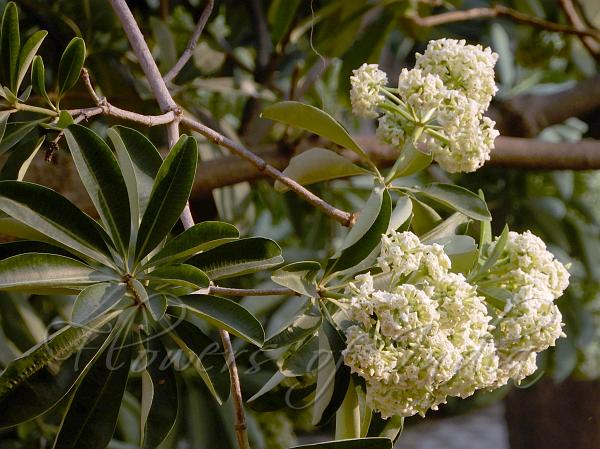|
| Scholar Tree |
|

|

| File size | 718031 |
| Original date | 10/9/18 5:20 PM |
| Resolution | 2048 x 1536 |
| Flash | Flash did not fire, auto |
| Focal length | 71.4mm |
| Exposure time | 1/125s |
| Aperture | 6.3 |
| Focus Distance | |
| Metering Mode | Center weighted average |
| Camera make | NIKON |
| Camera model | COOLPIX A900 |
| Sensor type |
|
|
|
|
Photo: |
Botanical name: Alstonia scholaris Family: Apocynaceae (Oleander family)
Synonyms: Echites scholaris
Synonyms: Echites scholaris
Scholar Tree is an elegant evergreen tree, found in
most parts of India. The generic name commemorates the distinguished
botanist, Prof. C. Alston of Edinburgh, 1685-1760. The species name
scholaris refers to the fact that the timber of this tree has
traditionally been used to make wooden slates for school children. In
October small, greenish white yet fragrant flowers appear. After sunset
the fragrance of the flowers prevails in the surroundings, leaving
most people wondering about the source of the scent as the flowers
themseleves are not very noticeable. All parts of the tree
can be considered poisonous. It is a tall elegant tree with greyish
rough bark. Branches are whorled, and so are the leaves, that is,
several of them coming out of the same point. The tree is really
elegant whether it is flowering or not. The slightly rounded, leathery,
dark green leaves form whorls of 4-7. And a very regular branching
gives the tree a beautiful shape. The wood is too soft for making
anything - so it is usually used in making packing boxes, blackboards
etc. On the Western Ghats, tribal people are reluctant to sit or pass
under this tree, for the fear of the devil. Local superstition about
its devilish character mainly stems from the fact that its milky sap is
rich in poisonous alkaloid, and thus the tree is shunned by cattle.
Medicinal uses: Its bark, known as Dita Bark,
is used in traditional medicine to treat dysentery and fever. In
Ayurveda it is used as a bitter and as an astringent herb for treating
skin disorders, malarial fever, urticaria, chronic dysentery, diarrhea,
in snake bite and for upper purification process of Panchakarma . The
Milky juice of the tree is applied to ulcers.
Its bark, known as Dita Bark,
is used in traditional medicine to treat dysentery and fever. In
Ayurveda it is used as a bitter and as an astringent herb for treating
skin disorders, malarial fever, urticaria, chronic dysentery, diarrhea,
in snake bite and for upper purification process of Panchakarma . The
Milky juice of the tree is applied to ulcers.
Medicinal uses:
 Its bark, known as Dita Bark,
is used in traditional medicine to treat dysentery and fever. In
Ayurveda it is used as a bitter and as an astringent herb for treating
skin disorders, malarial fever, urticaria, chronic dysentery, diarrhea,
in snake bite and for upper purification process of Panchakarma . The
Milky juice of the tree is applied to ulcers.
Its bark, known as Dita Bark,
is used in traditional medicine to treat dysentery and fever. In
Ayurveda it is used as a bitter and as an astringent herb for treating
skin disorders, malarial fever, urticaria, chronic dysentery, diarrhea,
in snake bite and for upper purification process of Panchakarma . The
Milky juice of the tree is applied to ulcers. | Identification credit: Tabish | Photographed in Delhi. |
• Is this flower misidentified? If yes,